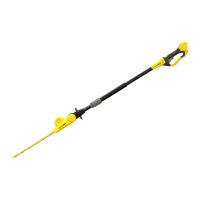13
ENGLISH
WORKING POSITIONS (Fig.D, F, G) – Maintain proper footing
and balance and do not overreach. Wear safety goggles, non-
skid footwear and gloves when trimming. Hold the tool firmly
in both hands and turn the tool ON. Always hold the trimmer, as
shown in the illustrations in this manual, with one hand on the
switch handle
14
and one hand on the foam gripper
4
( . Never
hold the tool by the handguard.
TRIMMING NEW GROWTH – Using a wide, sweeping motion,
feeding the blade teeth through the twigs, is most effective.
A slight downward tilt of the blade in the direction of motion
gives the bestcutting.
LEVEL HEDGES – To obtain exceptionally level hedges a piece
of string can be stretched along the length of the hedge as
aguide.
SIDE TRIMMING HEDGES (Fig.G) – Orient the trimmer as
shown and begin at the bottom and sweepup.
Guidelines for trimming (UK & Ireland)
• Trim hedges and shrubs with seasonal leaves (new leaves
every year) in June andOctober.
• Trim evergreens in April andAugust.
• Trim conifers and other fast growing shrubs every six weeks
from May untilOctober.
Guidelines for trimming (Australia & New
Zealand)
• Trim hedges and shrubs with seasonal leaves (new leaves
every year) in December andMarch.
• Trim evergreens in September andFebruary.
• Trim conifers and other fast growing shrubs every six weeks
from October untilMarch.
MAINTENANCE
Your STANLEYFATMAX power tool has been designed
to operate over a long period of time with a minimum of
maintenance. Continuous satisfactory operation depends upon
proper tool care and regularcleaning.
WARNING: To reduce the risk of serious personal
injury, turn tool off and disconnect battery pack
before making any adjustments or removing/
installing attachments or accessories. An accidental
start-up can causeinjury.
The charger and battery pack are notserviceable.
Lubrication
1. After use, carefully clean the blades with a resin solvent.
2. After cleaning, apply a light film of lubrication to the
exposedblade.
3. Turn the trimmer vertical with the blades toward the ground
and run the trimmer for a few seconds to fully disperse
thelubrication.
Transporting the Pole Hedge Trimmer
Always remove the battery from the tool when transporting the
Pole Hedge Trimmer. Hold pole at balance point with blades
towards therear.
Storing the Pole Hedge Trimmer
1. Disconnect battery fromtool.
2. The best storage place is one that is cool and dry away from
direct sunlight and excess heat orcold.
Cleaning
WARNING: Blow dirt and dust out of the main housing
with dry air as often as dirt is seen collecting in and around
the air vents. Wear approved eye protection and approved
dust mask when performing thisprocedure.
WARNING: Never use solvents or other harsh chemicals
for cleaning the non-metallic parts of the tool. These
chemicals may weaken the materials used in these parts.
Use a cloth dampened only with water and mild soap.
Never let any liquid get inside the tool; never immerse any
part of the tool into aliquid.
Optional Accessories
WARNING: Since accessories, other than those offered by
STANLEYFATMAX, have not been tested with this product,
use of such accessories with this tool could be hazardous.
To reduce the risk of injury, only STANLEYFATMAX
recommended accessories should be used with
thisproduct.
Consult your dealer for further information on the
appropriateaccessories.
Protecting the Environment
Separate collection. Products and batteries marked
with this symbol must not be disposed of with normal
household waste.
Products and batteries contain materials that can
be recovered or recycled reducing the demand for raw
materials. Please recycle electrical products and batteries
according to local provisions. Further information is available at
www.2helpU.com.
Rechargeable Battery Pack
This long life battery pack must be recharged when it fails
to produce sufficient power on jobs which were easily done
before. At the end of its technical life, discard it with due care for
our environment:
• Run the battery pack down completely, then remove it from
the tool.
• Li-Ion cells are recyclable. Take them to your dealer or a
local recycling station. The collected battery packs will be
recycled or disposed of properly.

